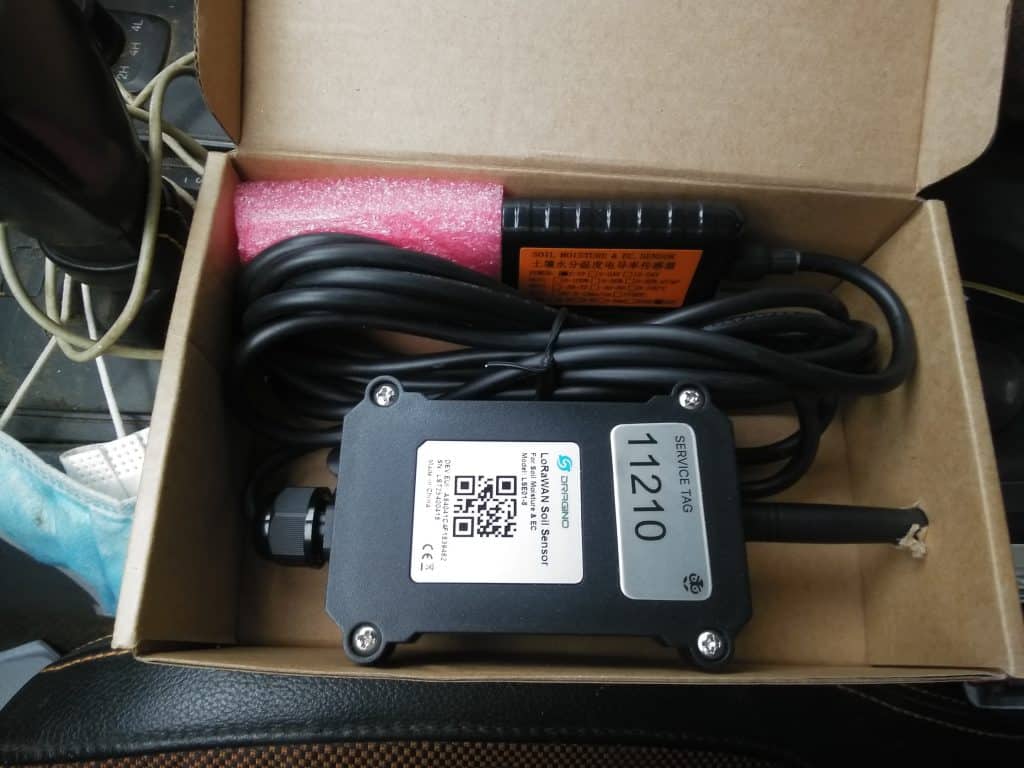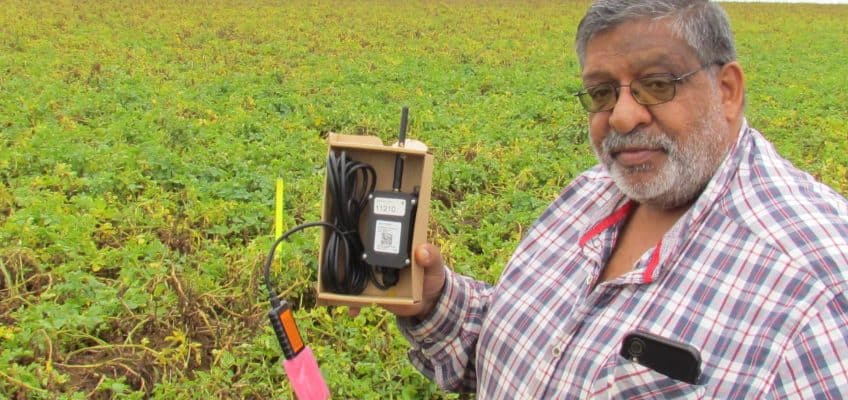By Glenys Christian
Featured image: Potatoes NZ board member and grower, Bharat Bhana, with an Adroit sensor in one of his potato paddocks close to Pukekohe. The yellow stick in the background marks where another sensor remains in the soil.
While vegetable growers have relied on knowing how much water their crops required by the length of their irrigation round now they need to be much more accurate, believes Pukekohe grower and Potatoes NZ director, Bharat Bhana.
He and his three brothers are directors of Hira Bhana which for more than 60 years has been growing over 600 hectares of crops around Pukekohe and Onewhero, of which around 120ha is leased. Potatoes make up a consistent 30 percent of their crops followed by onions, carrots, lettuce, brassicas, pumpkin and a small amount of watermelon.
Around 95 percent of their crops are irrigated with a combination of pivot and hard-hose irrigators, but only about one third of their potatoes.
“With the potato crops which are planted at the end of May we don’t have to irrigate them unless the ground is very dry when we want to dig them in November,” he says.
Water can also go on at a late growth stage to stop pest problems.
In the past he said timing of irrigation and the amount of water supplied to the crops was often determined by knowledge they had built up over many years.
“We’ve been at this game a long time,” he says.
Irrigation would be started when potatoes’ leaves started to droop, with timing depending on how long it would take to get around a particular block. But that could mean too much water was applied which could have been better used elsewhere.
But after being approached by Auckland-based company, Adroit, they now have 10 Dragino sensors placed in their fields. They give a read out every half an hour of soil moisture, temperature and electrical conductivity which is sent to them in real time via an app loaded on to their mobile phones.

The sensors are placed in a plastic tube, which can be dug into the soil at any depth required and can be moved easily from paddock to paddock depending on different crop requirements.
“You can make a lot better decisions on how much water to put on,” Bharat says.
“Whereas you might have been putting on 50 millimetres every 10 days, you may only need to apply 35mm to top soil moisture up.”
And that means the extra days’ irrigation which is saved can be made available for other crops which well need it.
The sensors were first used in August and September last year after discussions with Adroit, which specialises in environmental Internet of Things (IoT) technology in partnership with Spark IoT and Amazon Web Services (AWS).
“The beauty is that you can use them under any crops and make up your own mind about when and where you transfer them,” Bharat says.
The sensors can also be placed deeper into the ground as crops grow larger so the information they’re collecting and transmitting is always from the root zone.
“They’re pretty accurate,” he says.
“And they did exactly what Adroit said they would.”
The Bhanas had been using a service for several years where soil probes were placed on their land which would be checked every week. Then they would be supplied with a spreadsheet showing soil moisture results the day after the visit.
“Then we could make decisions and adjust what we were doing,” he said.
They were happy with the results and retained one of those probes in order to monitor the accuracy of the Adroit system. They’re also used one of the new probes in a potato paddock similar to another which doesn’t have one.
“In August we will have absolute proof,” Bharat says.
“If the tonnages are the same we will know we were wasting water.”
Of perhaps greater interest to the Bhanas is Adroit’s development work on a similar probe which it believes will soon be able to record nitrogen leaching.
“What’s coming down the tube with councils and Government is that we’ve got to be a lot more accurate,” Bharat says.
“They can be telling us we’re doing it wrong but they’ve never been in the field or grown anything.”
Growers know that if they don’t use a certain amount of N on their crops at certain times of year, they won’t be able to stay in business and keep providing vegetables for New Zealanders. But there was a fine line between putting on enough and too much. So they would need to have at hand information on inputs, as well as nutrients being leached out of their soils.
“We’ve got to get more scientifically based evidence on what we’re doing,” he says.
“Every grower is doing their own experiments because we’re all in the same boat.”
You can meet the Bhana Family and other Sustainability Champions at our PNZ Conference August 23rd & 24th 2022, Canterbury. See our events page for details https://potatoesnz.co.nz/news-info/events/



